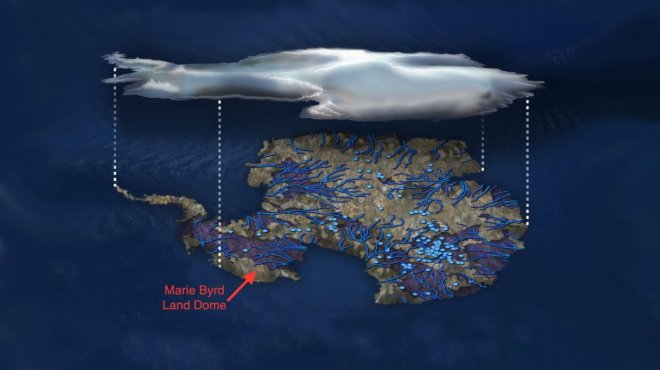
A recent NASA study revealed that the geothermal heat source called mantle plume which lies deep below the Marie Byrd Land in Antarctica results in ice melting in the region. Even though the heat source does not cause any additional threats, it still remains as a key for explaining the rapid ice sheet collapse in the early era of climate change which still persists as unstable even today.
Mantle plumes are believed to be narrow streams of hot, molten rock which erupts through Earth's mantle and forms a mushroom cap-like structure under the crust. The upward bulge is believed to be caused by the buoyancy of the material.
According to the 30 years old prediction by a scientist at the University of Colorado, heat from mantle plume under Marie Byrd Land might explain regional volcanic activity and the topographic dome feature. The very recent seismic images of the Polar Region have also supported this idea.
The stability of ice sheets in Polar Regions are determined by the volume of water which lubricates it from below which allows easy movement of glaciers. The rapid filling and draining of lakes and rivers in the Antarctica result in rising or falling of ice sheaths to nearly 20 feet (6 meters). The measurement of this phenomenon helps scientists to estimate the volume of water at the bottom of the ice sheaths.
Helene Seroussi and Erik Ivins of NASA's Jet Propulsion Laboratory in Pasadena, California, who conducted the recent research, used the Ice Sheet System Model (ISSM), a numerical depiction of the physics of ice sheets developed by scientists at JPL and the University of California, to prove the concept.
According to the research paper published in the Journal of Geophysical Research: Solid Earth, the researchers used ISSM to study the natural sources of heating and heat transfer, including freezing, melting, the volume of liquid water, friction, and other processes. The Numerical modeling helped to gain an idea of the functioning of the mantle plume concept.
The research model, which was based on NASA's IceSat Satellite and airborne Operation IceBridge campaign observed changes in the altitude of the ice sheet surface. Evik Ivins said, "These place a powerful constraint on allowable melt rates- the very thing we wanted to predict." The researchers used multiple parameters including dozens of different simulations as the location and size of the mantle plume is still unknown.
The researchers found that the energy flux from the mantle plume would not be more than 150 milliwatts per square meter. Whereas, the Yellowstone National Park in the US which is well known as a geothermal hotspot has an average heat flux of 200 milliwatts per square meter over the entire park, even though individual geothermal features like geysers will be much hotter.
The theory of mantle plumes was proposed during the 1970s to explain geothermal activities in regions of tectonic activities like the Hawaii and the Yellowstone.
According to the theories, the Marie Byrd Land mantle plume had been formed about 50 to 110 million years ago, even before the West Antarctic sheet came into existence. But by the end of the last ice age, around 11,000 years ago, the ice sheets faced rapid, sustained loss in its volume. The global weather pattern and rising sea levels have been forcing the warm water to flow closer to the ice sheets. The researchers say that the mantle plume catalyzes this global process.
Polar Region









